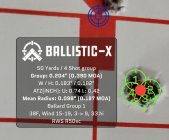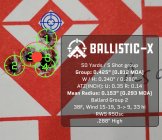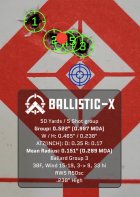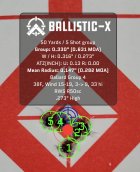In our focus on the new and novel, we sometimes forget how capable some of the old vintage smallbore rifles made in America are. And not just superstars like the Winchester Model 52E International, but some of the anonymous, semi-custom rifles assembled by/for serious shooters of all stripes. One such came home with me recently after whispering softly in my ear about how much she wanted to dance with me in a Vintage Smallbore match.
The first range day with my new-to-me Marlin Ballard No. 3 rifle was a pleasant surprise. She is definitely a bit of a mutt. The receiver is an early (1876) cast steel J. M. Marlin example. The action, although correct for a No. 3 rifle, appears much newer and all parts are unmarked. The trigger was opened, cleaned, lubricated and reassembled after receipt and breaks consistently at 2.5#. The barrel is a 29” .22lr heavy target barrel made by Eric Johnson in 1955. Her frock is a newer, tasteful, and unmarked target stock in cherry. Her head is adorned with a 20X Lyman Super Targetspot scope.
The weather was definitely NOT conducive to great shooting. The temperature was 38F, with winds blowing consistently 13-19 MPH from 9 o’clock to 3 0’clock. The high gust during the session was 33 MPH. A single surveyor’s tape was hung at the target and wind was judged by sight and sound intensity to attempt to minimize cross wind effect. The objective for the day was to get her on paper, then sighted for 50 yards... no more.
Once on paper at 25 yards, I zeroed at 50 yards with some older Wolf Match Extra. The Eric Johnson barrel produced better groups than expected, given the weather, so she whispered in my ear yet again and I agreed to feed her some RWS R50sc ammo to see what she could do with it. Results, determined with Ballistic-X software, are tabulated and illustrated below. All groups were five shot groups. However, the first shot in the first group, immediately after shifting ammo, was an obvious flyer and was excluded from tabulation.
All targets were shot with a front rest and rear bag. Shots were released holding center of the bull, attempting to squeeze off shots in relative lulls. Sights were adjusted between targets to bring POI closer to POA. I am pleased with how well the old gal followed in the challenging wind. Clearly group sizes were dominated by the crosswind, with deviation from the average in their sizes more than twice that of group heights. The much tighter range of vertical dispersion gives promise that this old battle axe will win her fair share of Vintage Smallbore matches this year. Heck, she



 may give those other club shooters and their shiny new Vudoo, Anschutz, and Turbo dance partners a scare on the monthly USBR, Dewar & ARA courses we fire!
may give those other club shooters and their shiny new Vudoo, Anschutz, and Turbo dance partners a scare on the monthly USBR, Dewar & ARA courses we fire!
The first range day with my new-to-me Marlin Ballard No. 3 rifle was a pleasant surprise. She is definitely a bit of a mutt. The receiver is an early (1876) cast steel J. M. Marlin example. The action, although correct for a No. 3 rifle, appears much newer and all parts are unmarked. The trigger was opened, cleaned, lubricated and reassembled after receipt and breaks consistently at 2.5#. The barrel is a 29” .22lr heavy target barrel made by Eric Johnson in 1955. Her frock is a newer, tasteful, and unmarked target stock in cherry. Her head is adorned with a 20X Lyman Super Targetspot scope.
The weather was definitely NOT conducive to great shooting. The temperature was 38F, with winds blowing consistently 13-19 MPH from 9 o’clock to 3 0’clock. The high gust during the session was 33 MPH. A single surveyor’s tape was hung at the target and wind was judged by sight and sound intensity to attempt to minimize cross wind effect. The objective for the day was to get her on paper, then sighted for 50 yards... no more.
Once on paper at 25 yards, I zeroed at 50 yards with some older Wolf Match Extra. The Eric Johnson barrel produced better groups than expected, given the weather, so she whispered in my ear yet again and I agreed to feed her some RWS R50sc ammo to see what she could do with it. Results, determined with Ballistic-X software, are tabulated and illustrated below. All groups were five shot groups. However, the first shot in the first group, immediately after shifting ammo, was an obvious flyer and was excluded from tabulation.
| Group Number | Group Size | Group Height | Group Mean Radius |
| 1 | 0.204” | 0.182” | 0.098” |
| 2 | 0.425” | 0.288” | 0.153” |
| 3 | 0.552” | 0.238” | 0.151” |
| 4 | 0.330” | 0.273” | 0.147” |
| Average | 0.378” | 0.245” | 0.163” |
All targets were shot with a front rest and rear bag. Shots were released holding center of the bull, attempting to squeeze off shots in relative lulls. Sights were adjusted between targets to bring POI closer to POA. I am pleased with how well the old gal followed in the challenging wind. Clearly group sizes were dominated by the crosswind, with deviation from the average in their sizes more than twice that of group heights. The much tighter range of vertical dispersion gives promise that this old battle axe will win her fair share of Vintage Smallbore matches this year. Heck, she




 may give those other club shooters and their shiny new Vudoo, Anschutz, and Turbo dance partners a scare on the monthly USBR, Dewar & ARA courses we fire!
may give those other club shooters and their shiny new Vudoo, Anschutz, and Turbo dance partners a scare on the monthly USBR, Dewar & ARA courses we fire!









